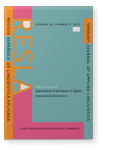The multilingual university website (MUW) genre ecology
Content analysis and translation processes
This article analyzes the content of Spanish university websites and the processes involved in translating them, with the aim of identifying the challenges internationalisation poses for these institutions and the technical, organisational, and translation-related solutions that have been adopted for managing their multilingual content, particularly in the case of universities in autonomous communities with two official languages. It examines the communicative situation of the multilingual university website (MUW) genre by applying textual genre analysis, with special emphasis on translation and localisation processes. The empirical study of the macrostructures, multilingual content, and strategies used by each university to translate its website is articulated through the notion of a genre ecology, as a complex conglomerate of genres based on distributed cognition and shared authorship. The analysis shows that the processes involved in creating multilingual content require adopting comprehensive translation and localisation strategies, establishing sole decision-makers for translation management and quality control, and providing the necessary resources to ensure the multifunctionality, dynamicity, interactivity, and adaptability we have identified in monolingual university websites. Finally, we offer suggestions for improving the creation, management and control of multilingual content, and define the profiles of the specialized translators required for this type of institutional website.
Article outline
- 1.Introduction
- 2.Complex conglomerates of genres, shared cognition, and the university website (UW) genre ecology
- 3.Analysis of Spanish UWs: Materials and methods
-
3.1Macrostructure: organisation of contents, functionalities, and applications
- 3.2Incorporating multilingual content
- 3.3Managing the process of creating and authoring multilingual content
- 3.4Incorporating translation technologies
- 4.Conclusions and suggestions for further work
-
Acknowledgements
- Notes
-
References
